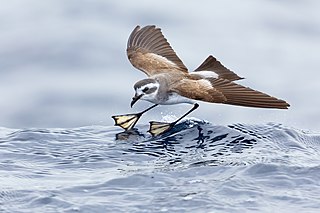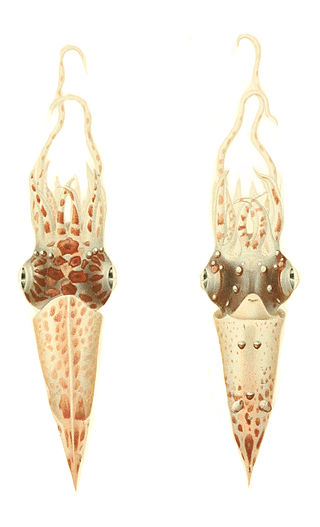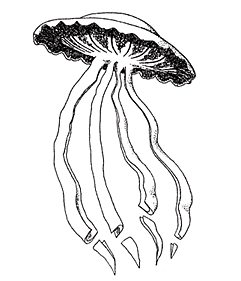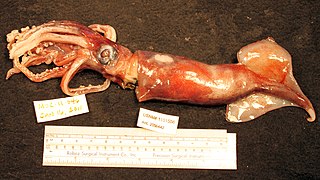
Deep-sea fish are fish that live in the darkness below the sunlit surface waters, that is below the epipelagic or photic zone of the sea. The lanternfish is, by far, the most common deep-sea fish. Other deep-sea fishes include the flashlight fish, cookiecutter shark, bristlemouths, anglerfish, viperfish, and some species of eelpout.

The white-faced storm petrel, also known as white-faced petrel or frigate petrel is a small seabird of the austral storm petrel family Oceanitidae. It is the only member of the monotypic genus Pelagodroma. It is widely distributed across the northern and southern hemisphere, especially around the coastal and open ocean waters of southern Australia, New Zealand, Tristan da Cunha, Cabo Verde, the Canary islands and the Selvagens islands.
The mesopelagiczone, also known as the middle pelagic or twilight zone, is the part of the pelagic zone that lies between the photic epipelagic and the aphotic bathypelagic zones. It is defined by light, and begins at the depth where only 1% of incident light reaches and ends where there is no light; the depths of this zone are between approximately 200 to 1,000 meters below the ocean surface.
The Neoteuthidae are a family of squid comprising four monotypic genera. They are thought to be the closest relatives to the famous giant squid.

The Antarctic fur seal is one of eight seals in the genus Arctocephalus, and one of nine fur seals in the subfamily Arctocephalinae. Despite what its name suggests, the Antarctic fur seal is mostly distributed in Subantarctic islands and its scientific name is thought to have come from the German vessel SMS Gazelle, which was the first to collect specimens of this species from Kerguelen Islands.

Pelagic fish live in the pelagic zone of ocean or lake waters—being neither close to the bottom nor near the shore—in contrast with demersal fish that live on or near the bottom, and reef fish that are associated with coral reefs.

A viperfish is any species of marine fish in the genus Chauliodus. Viperfishes are mostly found in the mesopelagic zone and are characterized by long, needle-like teeth and hinged lower jaws. A typical viperfish grows to lengths of 30 cm (12 in). Viperfishes undergo diel vertical migration and are found all around the world in tropical and temperate oceans. Viperfishes are capable of bioluminescence and possess photophores along the ventral side of their body, likely used to camouflage them by blending in with the less than 1% of light that reaches to below 200 meters depth.

Maurolicus muelleri, commonly referred to as Mueller's pearlside,Mueller's bristle-mouth fish, or the silvery lightfish, is a marine hatchetfish in the genus Maurolicus, found in deep tropical, subtropical and temperate waters of the Pacific Ocean and the Atlantic Ocean, from the surface to depths of 1,500 metres (4,900 ft). It can grow to a maximum total length of 8 centimetres (3.1 in).

The gummy shark, also known as the Australian smooth hound, flake, sweet william or smooth dog-shark, is a species of ground shark in the genus Mustelus of the family Triakidae. These small to medium-sized bottom-dwelling sharks are found mostly in, but are not limited to, the area around the southern seas of Australia and is commonly baited and fished for cuisine because of its taste and market prices. According to a 2021 paper by White, Arunrugstichai & Naylorn (2021), Mustelus walkeri is the same animal as M. antarcticus. One theory is that M. walkeri is a subpopulation of M. antarcticus.
Moroteuthopsis longimana, also known as the giant warty squid or longarm octopus squid, is a large species of hooked squid. It attains a mantle length of at least 85 cm and probably over 1.15 m. The largest complete specimen of this species, measuring 2.3 m in total length, was found in Antarctica in 2000.

Pterygioteuthis giardi is a species of squid in the family Pyroteuthidae. It is known as the roundear enope squid. The specific name honors the French zoologist and marine biologist Alfred Mathieu Giard (1846-1908).

The colossal squid is the world’s largest squid species and the world’s largest mollusc. It belongs to the Cranchiidae family, that of the cockatoo squids or glass squids. It is sometimes called the Antarctic cranch squid or giant squid and is believed to be the largest squid species in terms of mass. It is the only recognized member of the genus Mesonychoteuthis and is known from only a small number of specimens. The species is confirmed to reach a mass of at least 495 kilograms (1,091 lb), though the largest specimens—known only from beaks found in sperm whale stomachs—may perhaps weigh as much as 600–700 kilograms (1,300–1,500 lb), making it the largest known invertebrate. Maximum total length has been estimated between 10 metres (33 ft) and 14 metres (46 ft) but the former estimate is more likely. The colossal squid has the largest eyes of any known creature ever to exist, with an estimated diameter of 27–30 cm (11–12 in) to 40 cm (16 in) for the largest collected specimen.

The deep scattering layer, sometimes referred to as the sound scattering layer, is a layer in the ocean consisting of a variety of marine animals. It was discovered through the use of sonar, as ships found a layer that scattered the sound and was thus sometimes mistaken for the seabed. For this reason it is sometimes called the false bottom or phantom bottom. It can be seen to rise and fall each day in keeping with diel vertical migration.

Stygiomedusa gigantea, commonly known as the giant phantom jelly, is the only species in the monotypic genus of deep sea jellyfish, Stygiomedusa. It is in the Ulmaridae family. With only around 110 sightings in 110 years, it is a jellyfish that is rarely seen, but believed to be widespread throughout the world, with the exception of the Arctic Ocean.

Martialia hyadesii is a species of flying squid commonly known as the sevenstar flying squid. They have a maximum mantle length of 400mm, with a body weighing 820g.

Galiteuthis glacialis is a species of glass squid from the Antarctic Convergence. It is in the family Cranchiidae and subfamily Taoniinae. They are endemic to the Antarctic and are found in the Southern Ocean, around the Weddell Sea and the South Shetland Islands. Galiteuthis glacialis are one of the most plentiful and widely dispersed species of Antarctic squid. These squids are found in the mesopelagic and bathypelagic layers of the open ocean and demonstrate vertical migration. They can reach a maximum mantle length of 500 mm (0.5m).

Gonatus antarcticus is a squid in the family Gonatidae. The species is known with certainty only from southern Atlantic waters but it may have a circum-Antarctic distribution.

Histioteuthis heteropsis, known as the strawberry squid, is a species of small cock-eyed squid. The scientific nomenclature of these squid stems from their set of differently sized eyes, one being small and blue and the other being large and yellow. It is thought that the large eye is used to see objects against dim light, while the smaller eye is more able to view bioluminescent light sources. The squid's vernacular name arose due to its rich red skin pigmentation and the presence of photophores along its body, making it appear like a strawberry with seeds.

Ornithoteuthis antillarum, the Atlantic bird squid, is a species of flying squid from the family Ommastrephidae which is found in the warmer waters of the Atlantic Ocean. This species is an important component of the diet of many species of fish and of cetaceans. It is taken as a bycatch in fisheries but has the potential to be commercially important if appropriate fishing methods can be developed.
A micronekton is a group of organisms of 2 to 20 cm in size which are able to swim independently of ocean currents. The word 'nekton' is derived from the Greek νήκτον, translit. nekton, meaning "to swim", and was coined by Ernst Haeckel in 1890.
















